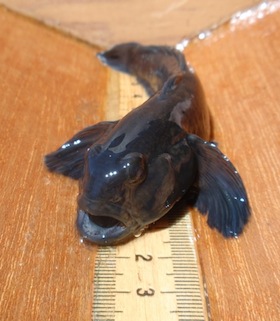Invasive fish enters streams feeding Lake Michigan, but so far, so good
Invasive species are known for disturbing their new homes. Whether it’s the zebra mussels in the Great Lakes or garlic mustard in native woodlands, their rampant multiplication crowds out native species.
But according to research just published in the journal Diversity and Distributions, that’s not yet happening as a fish called the round goby advances up dozens of streams along Wisconsin’s watery eastern border.

Round gobies, a fish invading streams in Eastern Wisconsin, are usually a mottled, beige/brown color, but males like this turn jet black during spawning. This fish is about 12 centimeters (5 inches) in length.
Photo: Erika Nilsson, UW–Madison
After University of Wisconsin–Madison undergraduates discovered the round goby in one of these streams in 2005, Matthew Kornis focused on the fish while earning a Ph.D. in limnology and marine science. Using an assortment of fish sampling methods, Kornis counted fish in 73 streams along the Lake Michigan and Green Bay shores.
By the end of his study, the round goby had invaded 26 of them, covering 175 river miles.
Between 2007 and 2011, the round goby population rose an average of almost 1,100 percent in the streams he monitored, Kornis says. At four of the 26 streams with round goby, between 32 and 83 percent of all fish caught were round gobies. In the other invaded streams, gobies comprised only 9 percent of the catch.
Based on experience in Lake Michigan, the researchers expected that native species would be displaced by such an invasion, yet as round goby populations surged, the population of five native fishes (Johnny darter, mottled sculpin, logperch, fantail darter and blackside darter) were not significantly reduced overall. “We chose the comparison species because their abundance in areas of Lake Michigan fell close to zero within four years of the round goby’s arrival,” says Kornis. “The round goby is also well-known for eating the eggs and young of sport fish, including bass, walleye and trout.”
The round goby is aggressive, says Jake Vander Zanden, a professor at UW–Madison’s Center for Limnology, who supervised the research, and that seems to be a key advantage. “They are literally beating up other fish.” Such rude manners enable the round goby to monopolize the best spawning sites, where they are protected from predators, says Kornis.
Kornis, whose work was supported by the University of Wisconsin Sea Grant program, is now at the Smithsonian Environmental Research Center in Maryland.
Based on experience in Lake Michigan, the researchers expected that native species would be displaced by such an invasion, yet as round goby populations surged, the population of five native fishes were not significantly reduced overall.
Round gobies were accidentally brought to the Great Lakes no later than 1990, in ballast water dumped by cargo ships. Ballast water, the Environmental Protection Agency says, is responsible for 30 percent of at least 180 invasives in the Great Lakes. The goby originated in Asia, in the Black and Caspian Seas, where it evolved to eat zebra and quagga mussels, two of the worst invasive pests in the Great Lakes. Because few fish eat these mussels, “the gobies have the market cornered for these abundant food sources,” Kornis says.
Although the study strays from the typical “sky-is-falling” narrative about invasive species, the fish is still multiplying, and trouble might loom. “It’s interesting,” says Kornis, “that although native fishes generally did not decline as expected, the four sites with the highest abundance of round gobies had 30 percent fewer native fishes on average than other sites within those same streams. Since we know that the round goby is rapidly increasing in these streams, that raises concerns about a greater impact.”
The simple fact that the round goby could inhabit these streams “was a big surprise,” says Vander Zanden. “These cases can be remarkably unpredictable. They could be a huge problem, and knock out a bunch of natives, or just sit where they are now, and become part of the community.”
And even though invaders have altered many ecosystems, they must abide the rules of nature, says Vander Zanden, an expert on invasives. “Every species has a set of conditions that it can live under, though many invasives can live under a wide range of conditions. Still, it’s remarkable. A huge lake and a tiny stream are such different habitats.
“The research tells a story,” Vander Zanden says. “Nature is constantly dealing us surprises. And it’s revealing about science — it’s not a straight-line process. Things happen that you don’t expect. We had this idea that the round goby would only live in these large lakes, but it can live in other environments, even if nobody would have predicted that.”




